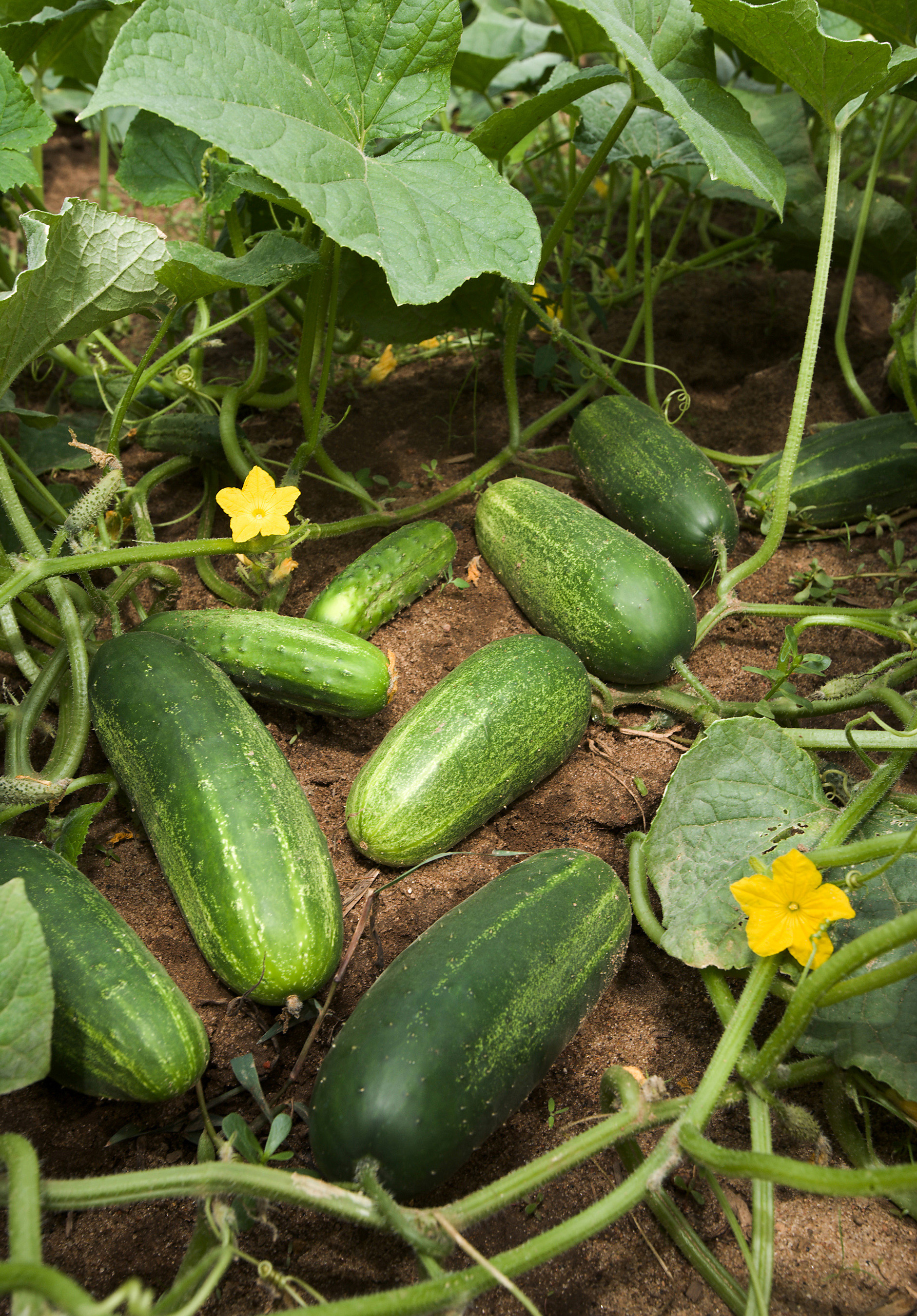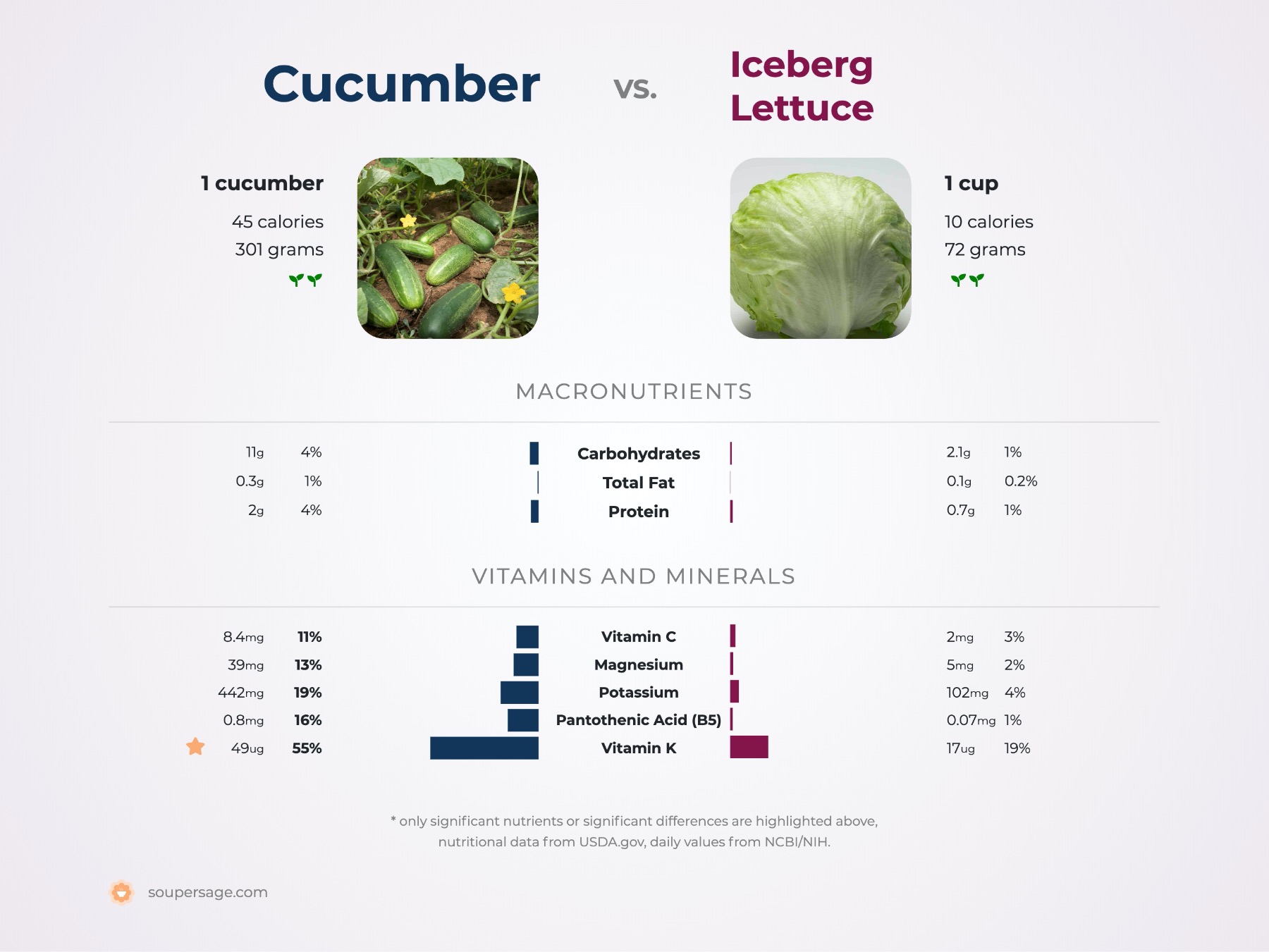Cucumber vs. Iceberg Lettuce
Nutrition comparison of Cucumber and Iceberg Lettuce
Ever wonder how your favorite foods stack up against each other in terms of nutrition?
We compared the nutritional contents of
cucumber
versus
iceberg lettuce
(100g each)
below using 2020 USDA and NIH data[1].
For a quick recap of significant nutrients and differences in cucumber and iceberg lettuce:
- Cucumber has more pantothenic acid, however, iceberg lettuce contains more folate.
USDA sources for nutritional information: Cucumber (Cucumber, with peel, raw) and Iceberg Lettuce (Lettuce, iceberg (includes crisphead types), raw) . Have a correction or suggestions? Shoot us an email.
Calories and Carbs
calories
Cucumber and iceberg lettuce contain similar amounts of calories - cucumber has 15 calories per 100 grams and iceberg lettuce has 14 calories.
For macronutrient ratios, cucumber is lighter in protein, heavier in carbs and similar to iceberg lettuce for fat. Cucumber has a macronutrient ratio of 15:80:5 and for iceberg lettuce, 21:72:8 for protein, carbohydrates and fat from calories.
Macro Ratios from Calories:
| Cucumber | Iceberg Lettuce | |
|---|---|---|
| Protein | 15% | 21% |
| Carbohydrates | 80% | 72% |
| Fat | 5% | 8% |
| Alcohol | ~ | ~ |
carbohydrates
Both cucumber and iceberg lettuce are low in carbohydrates - cucumber has 3.6g of total carbs per 100 grams and iceberg lettuce has 3g of carbohydrates.
The carbs in cucumber are made of 56% sugar, 28% starch and 17% dietary fiber, whereas the carbs in iceberg lettuce comprise of 62% sugar and 38% dietary fiber.
dietary fiber
Iceberg lettuce has 140% more dietary fiber than cucumber - cucumber has 0.5g of dietary fiber per 100 grams and iceberg lettuce has 1.2g of dietary fiber.
sugar
Cucumber and iceberg lettuce contain similar amounts of sugar - cucumber has 1.7g of sugar per 100 grams and iceberg lettuce has 2g of sugar.
Protein
protein
Cucumber and iceberg lettuce contain similar amounts of protein - cucumber has 0.65g of protein per 100 grams and iceberg lettuce has 0.9g of protein.
Fat
saturated fat
Both cucumber and iceberg lettuce are low in saturated fat - cucumber has 0.04g of saturated fat per 100 grams and iceberg lettuce has 0.02g of saturated fat.
Vitamins
Vitamin C
Cucumber and iceberg lettuce contain similar amounts of Vitamin C - cucumber has 2.8mg of Vitamin C per 100 grams and iceberg lettuce has 2.8mg of Vitamin C.
Vitamin A
Iceberg lettuce has 400% more Vitamin A than cucumber - cucumber has 5ug of Vitamin A per 100 grams and iceberg lettuce has 25ug of Vitamin A.
Vitamin E
Cucumber and iceberg lettuce contain similar amounts of Vitamin E - cucumber has 0.03mg of Vitamin E per 100 grams and iceberg lettuce has 0.18mg of Vitamin E.
Vitamin K
Cucumber and iceberg lettuce contain similar amounts of Vitamin K - cucumber has 16.4ug of Vitamin K per 100 grams and iceberg lettuce has 24.1ug of Vitamin K.
The B Vitamins
Cucumber has more pantothenic acid, however, iceberg lettuce contains more folate. Both cucumber and iceberg lettuce contain significant amounts of thiamin, riboflavin, niacin and Vitamin B6.
| Cucumber | Iceberg Lettuce | |
|---|---|---|
| Thiamin | 0.027 MG | 0.041 MG |
| Riboflavin | 0.033 MG | 0.025 MG |
| Niacin | 0.098 MG | 0.123 MG |
| Pantothenic acid | 0.259 MG | 0.091 MG |
| Vitamin B6 | 0.04 MG | 0.042 MG |
| Folate | 7 UG | 29 UG |
Minerals
calcium
Cucumber and iceberg lettuce contain similar amounts of calcium - cucumber has 16mg of calcium per 100 grams and iceberg lettuce has 18mg of calcium.
iron
Cucumber and iceberg lettuce contain similar amounts of iron - cucumber has 0.28mg of iron per 100 grams and iceberg lettuce has 0.41mg of iron.
potassium
Cucumber and iceberg lettuce contain similar amounts of potassium - cucumber has 147mg of potassium per 100 grams and iceberg lettuce has 141mg of potassium.
Antioxidants and Phytonutrients
flavonoids
Naturally occuring in fruits and vegetables, flavonoids are associated with many health benefits and used in a variety of medicinal and pharmaceutical applications. [2][3]
For specific flavonoid compounds, both cucumber and iceberg lettuce contain small amounts of kaempferol.
| Cucumber | Iceberg Lettuce | |
|---|---|---|
| kaempferol | 0.13 mg | 0.15 mg |
| Quercetin | 0.04 mg | 1.42 mg |
| apigenin | ~ | 0.13 mg |
| luteolin | ~ | 0.03 mg |
| myricetin | ~ | 0.06 mg |
carotenoids
Carotenoids are micronutrients commonly found in plants and some animal products. An example is beta-carotene, the notable carotenoid which is a popular source of Vitamin A.[4][5]
For specific types of carotenoids, both cucumber and iceberg lettuce contain small amounts of alpha-carotene.
| Cucumber | Iceberg Lettuce | |
|---|---|---|
| beta-carotene | 45 UG | 299 UG |
| alpha-carotene | 11 UG | 4 UG |
| lutein + zeaxanthin | 23 UG | 277 UG |
Omega-3 and Omega-6
omega 3s
For omega-3 fatty acids, iceberg lettuce has more alpha linoleic acid (ALA) than cucumber per 100 grams.
| Cucumber | Iceberg Lettuce | |
|---|---|---|
| alpha linoleic acid | 0.005 G | 0.052 G |
| Total | 0.005 G | 0.052 G |
omega 6s
Comparing omega-6 fatty acids, both cucumber and iceberg lettuce contain small amounts of linoleic acid.
| Cucumber | Iceberg Lettuce | |
|---|---|---|
| linoleic acid | 0.028 G | 0.021 G |
| Total | 0.028 G | 0.021 G |
Customize your serving size
The comparison below is by common portions, e.g. cups, packages. You can also see a more concrete comparison by weight at equal weight (by grams) comparison.
Note: The specific food items compared are: Cucumber (Cucumber, with peel, raw) and Iceberg Lettuce (Lettuce, iceberg (includes crisphead types), raw) .
Cucumber g
()
|
Daily Values (%) |
Iceberg Lettuce g
()
|
|||||
|---|---|---|---|---|---|---|---|
| KCAL % |
|
5% | calories | 5% |
|
KCAL % | |
| G % |
|
5% | carbohydrates | 5% |
|
G % | |
| G % |
|
5% | dietary fiber | 5% |
|
G % | |
| G | 5% | sugar | 5% | G | |||
| G % |
|
5% | total fat | 5% |
|
G % | |
| G % |
|
5% | saturated fat | 5% |
|
G % | |
| G | 5% | monounsaturated fat | 5% | G | |||
| G | 5% | polyunsaturated fat | 5% | G | |||
| G | 5% | trans fat | 5% | G | |||
| MG | 5% | cholesterol | 5% | MG | |||
| MG % |
|
5% | sodium | 5% |
|
MG % | |
| 5% | Vitamins and Minerals | 5% | |||||
| UG % |
|
5% | Vitamin A | 5% |
|
UG % | |
| MG % |
|
5% | Vitamin C | 5% |
|
MG % | |
| IU % |
|
5% | Vitamin D | 5% |
|
IU % | |
| MG % |
|
5% | calcium | 5% |
|
MG % | |
| MG % |
|
5% | iron | 5% |
|
MG % | |
| MG % |
|
5% | magnesium | 5% |
|
MG % | |
| MG % |
|
5% | potassium | 5% |
|
MG % | |
| MG % |
|
5% | thiamin (Vit B1) | 5% |
|
MG % | |
| MG % |
|
5% | riboflavin (Vit B2) | 5% |
|
MG % | |
| MG % |
|
5% | niacin (Vit B3) | 5% |
|
MG % | |
| MG % |
|
5% | Vitamin B6 | 5% |
|
MG % | |
| MG % |
|
5% | pantothenic acid (Vit B5) | 5% |
|
MG % | |
| UG % |
|
5% | folate (Vit B9) | 5% |
|
UG % | |
| UG % |
|
5% | Vitamin B12 | 5% |
|
UG % | |
| MG % |
|
5% | Vitamin E | 5% |
|
MG % | |
| UG % |
|
5% | Vitamin K | 5% |
|
UG % | |
| G % |
|
5% | protein | 5% |
|
G % | |
| UG % |
|
5% | biotin (Vit B7) | 5% |
|
UG % | |
| MG % |
|
5% | choline | 5% |
|
MG % | |
| MG % |
|
5% | chlorine | 5% |
|
MG % | |
| UG % |
|
5% | chromium | 5% |
|
UG % | |
| MG % |
|
5% | copper | 5% |
|
MG % | |
| UG % |
|
5% | fluoride | 5% |
|
UG % | |
| UG % |
|
5% | iodine | 5% |
|
UG % | |
| MG % |
|
5% | manganese | 5% |
|
MG % | |
| UG % |
|
5% | molybdenum | 5% |
|
UG % | |
| MG % |
|
5% | phosphorus | 5% |
|
MG % | |
| UG % |
|
5% | selenium | 5% |
|
UG % | |
| MG % |
|
5% | zinc | 5% |
|
MG % | |
| G | 5% | Water | 5% | G | |||
| G | 5% | Starch | 5% | G | |||
| G | 5% | Alcohol | 5% | G | |||
FAQ
Does cucumber or iceberg lettuce contain more calories in 100 grams?Cucumber and iceberg lettuce contain similar amounts of calories - cucumber has 15 calories in 100g and iceberg lettuce has 14 calories.
Does cucumber or iceberg lettuce have more carbohydrates?
By weight, both cucumber and iceberg lettuce are low in carbohydrates - cucumber has 3.6g of carbs for 100g and iceberg lettuce has 3g of carbohydrates. the carbs in cucumber are made of 60% sugar, 30% starch and 20% dietary fiber, whereas the carbs in iceberg lettuce comprise of 60% sugar and 40% dietary fiber.


